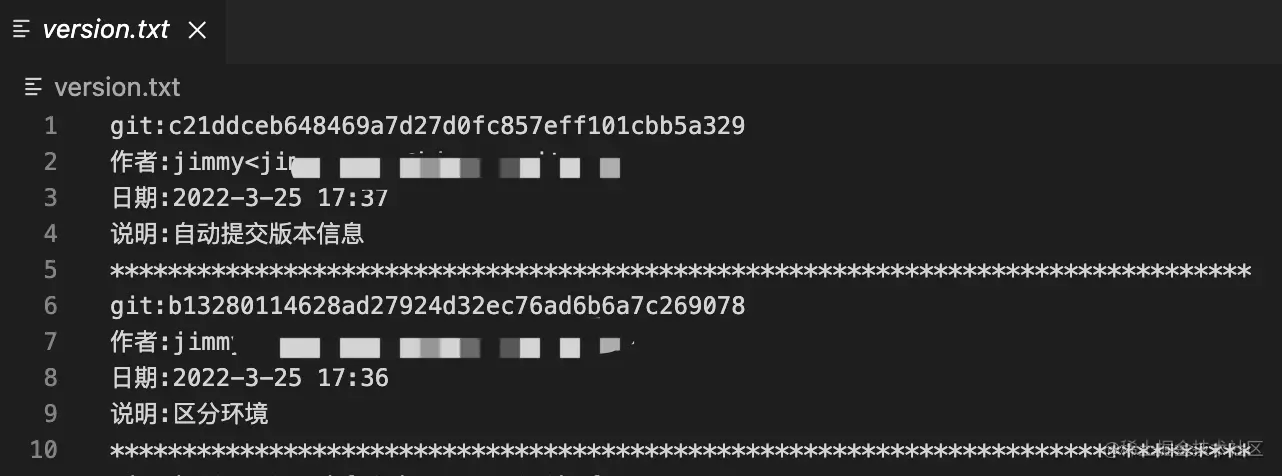这篇文章主要介绍angular如何结合git Commit进行版本处理,文中介绍的非常详细,具有一定的参考价值,感兴趣的小伙伴们一定要看完!上图是页面上展示的测试环境/开发环境版本信息。后面有介绍上图表示的
这篇文章主要介绍angular如何结合git Commit进行版本处理,文中介绍的非常详细,具有一定的参考价值,感兴趣的小伙伴们一定要看完!

后面有介绍

上图表示的是每次提交的Git Commit的信息,当然,这里我是每次提交都记录,你可以在每次构建的时候记录。
So,我们接下来用 Angular 实现下效果,React 和 Vue 同理。
因为这里的重点不是搭建环境,我们直接用 angular-cli 脚手架直接生成一个项目就可以了。
Step 1: 安装脚手架工具
npm install -g @angular/cliStep 2: 创建一个项目
# ng new PROJECT_NAME
ng new ng-commitStep 3: 运行项目
npm run start项目运行起来,默认监听4200端口,直接在浏览器打开Http://localhost:4200/就行了。
4200 端口没被占用的前提下
此时,ng-commit 项目重点文件夹 src 的组成如下:
src
├── app // 应用主体
│ ├── app-routing.module.ts // 路由模块
│ .
│ └── app.module.ts // 应用模块
├── assets // 静态资源
├── main.ts // 入口文件
.
└── style.less // 全局样式上面目录结构,我们后面会在 app 目录下增加 services 服务目录,和 assets 目录下的 version.JSON文件。
在根目录创建一个文件version.txt,用于存储提交的信息;在根目录创建一个文件commit.js,用于操作提交信息。
重点在commit.js,我们直接进入主题:
const execSync = require('child_process').execSync;
const fs = require('fs')
const versionPath = 'version.txt'
const buildPath = 'dist'
const autoPush = true;
const commit = execSync('git show -s --fORMat=%H').toString().trim(); // 当前的版本号
let versionStr = ''; // 版本字符串
if(fs.existsSync(versionPath)) {
versionStr = fs.readFileSync(versionPath).toString() + '\n';
}
if(versionStr.indexOf(commit) != -1) {
console.warn('\x1B[33m%s\x1b[0m', 'warming: 当前的git版本数据已经存在了!\n')
} else {
let name = execSync('git show -s --format=%cn').toString().trim(); // 姓名
let email = execSync('git show -s --format=%ce').toString().trim(); // 邮箱
let date = new Date(execSync('git show -s --format=%cd').toString()); // 日期
let message = execSync('git show -s --format=%s').toString().trim(); // 说明
versionStr = `git:${commit}\n作者:${name}<${email}>\n日期:${date.getFullYear()+'-'+(date.getMonth()+1)+'-'+date.getDate()+' '+date.getHours()+':'+date.getMinutes()}\n说明:${message}\n${new Array(80).join('*')}\n${versionStr}`;
fs.writeFileSync(versionPath, versionStr);
// 写入版本信息之后,自动将版本信息提交到当前分支的git上
if(autoPush) { // 这一步可以按照实际的需求来编写
execSync(`git add ${ versionPath }`);
execSync(`git commit ${ versionPath } -m 自动提交版本信息`);
execSync(`git push origin ${ execSync('git rev-parse --abbrev-ref HEAD').toString().trim() }`)
}
}
if(fs.existsSync(buildPath)) {
fs.writeFileSync(`${ buildPath }/${ versionPath }`, fs.readFileSync(versionPath))
}上面的文件可以直接通过 node commit.js 进行。为了方便管理,我们在 package.json 上加上命令行:
"scripts": {
"commit": "node commit.js"
}那样,使用 npm run commit 同等 node commit.js 的效果。
有了上面的铺垫,我们可以通过 commit 的信息,生成指定格式的版本信息version.json了。
在根目录中新建文件version.js用来生成版本的数据。
const execSync = require('child_process').execSync;
const fs = require('fs')
const targetFile = 'src/assets/version.json'; // 存储到的目标文件
const commit = execSync('git show -s --format=%h').toString().trim(); //当前提交的版本号,hash 值的前7位
let date = new Date(execSync('git show -s --format=%cd').toString()); // 日期
let message = execSync('git show -s --format=%s').toString().trim(); // 说明
let versionObj = {
"commit": commit,
"date": date,
"message": message
};
const data = JSON.stringify(versionObj);
fs.writeFile(targetFile, data, (err) => {
if(err) {
throw err
}
console.log('Stringify Json data is saved.')
})我们在 package.json 上加上命令行方便管理:
"scripts": {
"version": "node version.js"
}针对不同的环境生成不同的版本信息,假设我们这里有开发环境 development,生产环境 production 和车测试环境 test。
生产环境版本信息是 major.minor.patch,如:1.1.0
开发环境版本信息是 major.minor.patch:beta,如:1.1.0:beta
测试环境版本信息是 major.minor.path-data:hash,如:1.1.0-2022.01.01:4rtr5rg
方便管理不同环境,我们在项目的根目录中新建文件如下:
config
├── default.json // 项目调用的配置文件
├── development.json // 开发环境配置文件
├── production.json // 生产环境配置文件
└── test.json // 测试环境配置文件相关的文件内容如下:
// development.json
{
"env": "development",
"version": "1.3.0"
}// production.json
{
"env": "production",
"version": "1.3.0"
}// test.json
{
"env": "test",
"version": "1.3.0"
}default.json 根据命令行拷贝不同环境的配置信息,在 package.json 中配置下:
"scripts": {
"copyConfigProduction": "cp ./config/production.json ./config/default.json",
"copyConfigDevelopment": "cp ./config/development.json ./config/default.json",
"copyConfigTest": "cp ./config/test.json ./config/default.json",
}Is easy Bro, right?
整合生成版本信息的内容,得到根据不同环境生成不同的版本信息,具体代码如下:
const execSync = require('child_process').execSync;
const fs = require('fs')
const targetFile = 'src/assets/version.json'; // 存储到的目标文件
const config = require('./config/default.json');
const commit = execSync('git show -s --format=%h').toString().trim(); //当前提交的版本号
let date = new Date(execSync('git show -s --format=%cd').toString()); // 日期
let message = execSync('git show -s --format=%s').toString().trim(); // 说明
let versionObj = {
"env": config.env,
"version": "",
"commit": commit,
"date": date,
"message": message
};
// 格式化日期
const formatDay = (date) => {
let formatted_date = date.getFullYear() + "." + (date.getMonth()+1) + "." +date.getDate()
return formatted_date;
}
if(config.env === 'production') {
versionObj.version = config.version
}
if(config.env === 'development') {
versionObj.version = `${ config.version }:beta`
}
if(config.env === 'test') {
versionObj.version = `${ config.version }-${ formatDay(date) }:${ commit }`
}
const data = JSON.stringify(versionObj);
fs.writeFile(targetFile, data, (err) => {
if(err) {
throw err
}
console.log('Stringify Json data is saved.')
})在 package.json 中添加不同环境的命令行:
"scripts": {
"build:production": "npm run copyConfigProduction && npm run version",
"build:development": "npm run copyConfigDevelopment && npm run version",
"build:test": "npm run copyConfigTest && npm run version",
}生成的版本信息会直接存放在 assets 中,具体路径为 src/assets/version.json。
最后一步,在页面中展示版本信息,这里是跟 angular 结合。
使用 ng generate service version 在 app/services 目录中生成 version 服务。在生成的 version.service.ts 文件中添加请求信息,如下:
import { Injectable } from '@angular/core';
import { HttpClient } from '@angular/common/http';
import { Observable } from 'rxjs';
@Injectable({
providedIn: 'root'
})
export class VersionService {
constructor(
private http: HttpClient
) { }
public getVersion():Observable<any> {
return this.http.get('assets/version.json')
}
}要使用请求之前,要在 app.module.ts 文件挂载 HttpClientModule 模块:
import { HttpClientModule } from '@angular/common/http';
// ...
imports: [
HttpClientModule
],之后在组件中调用即可,这里是 app.component.ts 文件:
import { Component } from '@angular/core';
import { VersionService } from './services/version.service'; // 引入版本服务
@Component({
selector: 'app-root',
templateUrl: './app.component.html',
styleUrls: ['./app.component.less']
})
export class AppComponent {
public version: string = '1.0.0'
constructor(
private readonly versionService: VersionService
) {}
nGonInit() {
this.versionService.getVersion().subscribe({
next: (data: any) => {
this.version = data.version // 更改版本信息
},
error: (error: any) => {
console.error(error)
}
})
}
}至此,我们完成了版本信息。我们最后来调整下 package.json 的命令:
"scripts": {
"start": "ng serve",
"version": "node version.js",
"commit": "node commit.js",
"build": "ng build",
"build:production": "npm run copyConfigProduction && npm run version && npm run build",
"build:development": "npm run copyConfigDevelopment && npm run version && npm run build",
"build:test": "npm run copyConfigTest && npm run version && npm run build",
"copyConfigProduction": "cp ./config/production.json ./config/default.json",
"copyConfigDevelopment": "cp ./config/development.json ./config/default.json",
"copyConfigTest": "cp ./config/test.json ./config/default.json"
}使用 scripts 一是为了方便管理,而是方便 jenkins 构建方便调用。对于 jenkins 部分,感兴趣者可以自行尝试。
以上是“Angular如何结合Git Commit进行版本处理”这篇文章的所有内容,感谢各位的阅读!希望分享的内容对大家有帮助,更多相关知识,欢迎关注编程网JavaScript频道!
--结束END--
本文标题: Angular如何结合Git Commit进行版本处理
本文链接: https://lsjlt.com/news/96976.html(转载时请注明来源链接)
有问题或投稿请发送至: 邮箱/279061341@qq.com QQ/279061341
2024-01-12
2023-05-20
2023-05-20
2023-05-20
2023-05-20
2023-05-20
2023-05-20
2023-05-20
2023-05-20
2023-05-20
回答
回答
回答
回答
回答
回答
回答
回答
回答
回答
0